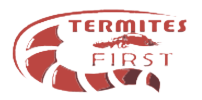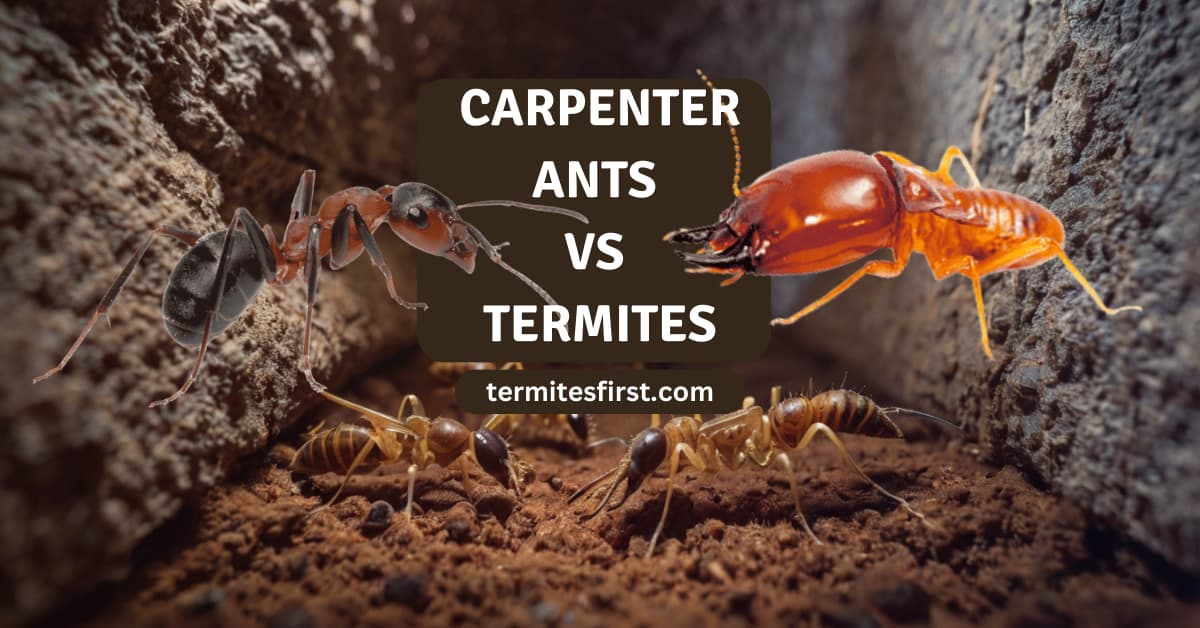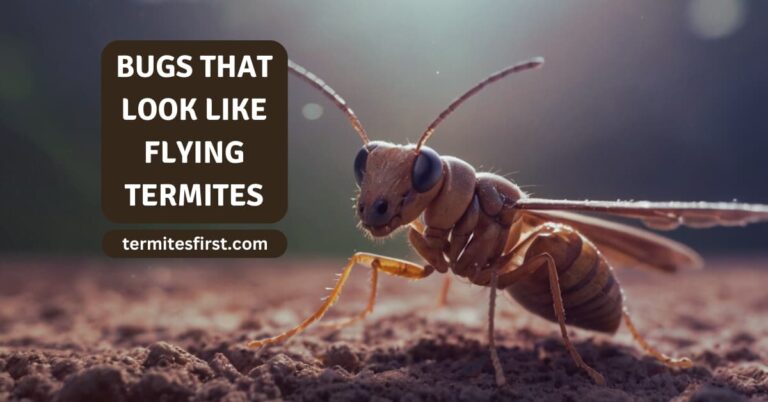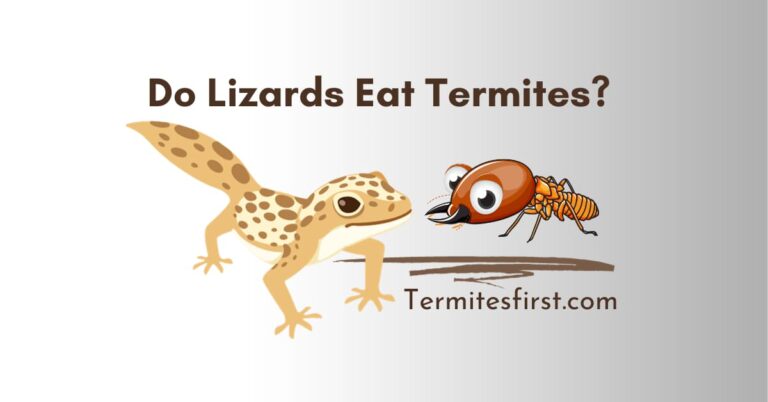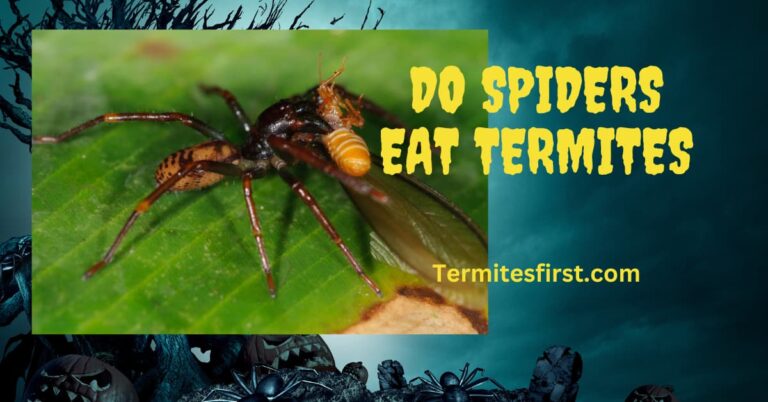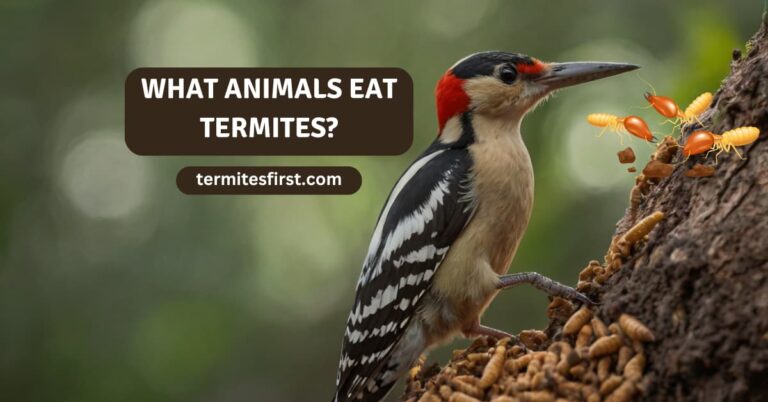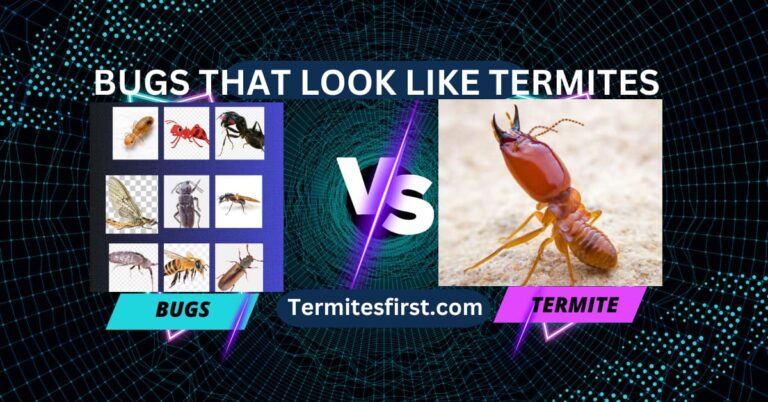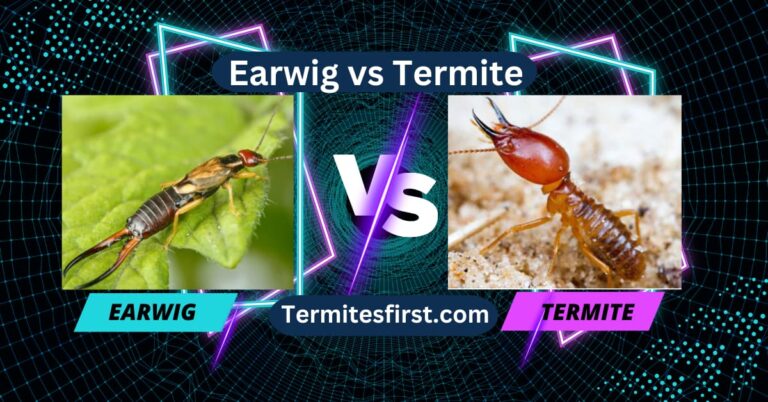Carpenter Ants vs Termites: How I Identify the Differences
Carpenter ants and termites trick many homeowners every year because of their shared destructive behavior of nesting in wooden buildings. I quickly learned just how important it was to be able to distinguish these pests to save my home from damage.
Carpenter ants are larger and hollow out their homes in wood without eating it, whereas termites eat the wood, which causes more damage. Knowing how to identify the differences will allow you to select the appropriate treatment method, saving you time and money.
Knowing these pests is an important first step to effective pest management.
Points to be Noted:
- Learn to identify the key physical differences between carpenter ants and termites. Look specifically at their body silhouettes, antennae, and wing patterns to identify these pests quickly and easily.
- Learn how to tell carpenter ants and termites apart by looking at their color patterns. These patterns serve as visual indicators to help you tell the two species apart.
- Watch out for changes in pest behavior. Their habitat preferences and dietary habits strongly affect the kind of damage they do to buildings.
- Identify tell-tale signs to detect infestations early. Indicators such as sawdust from carpenter ants and mud tubes from termites will allow you to stop costly destruction before it starts.
- Save time and money with simple, smart strategies that work to control each pest more effectively. Seal all entry points for carpenter ants and install baiting systems for termites, and consult with pest control experts for best results.
- Keep things dry and inspect regularly to prevent infestations. Go all out on prevention to avoid carpenter ants and termites before they start.
Physical Characteristics Comparison
Understanding the distinct body segments of carpenter ants and termites can help you spot termites more effectively. This knowledge is critical for pest control professionals to implement effective control measures against these destructive pests. Their wings, antennae, and colors reveal key differences that are both beautiful and educational.
Body Shape Differences
Carpenter ants and termites each have unique body shapes that are fairly simple to identify. Carpenter ants are easily identified by their pinched waist, which provides them with a unique, segmented appearance. This design gives them a natural division between their head, thorax, and abdomen.
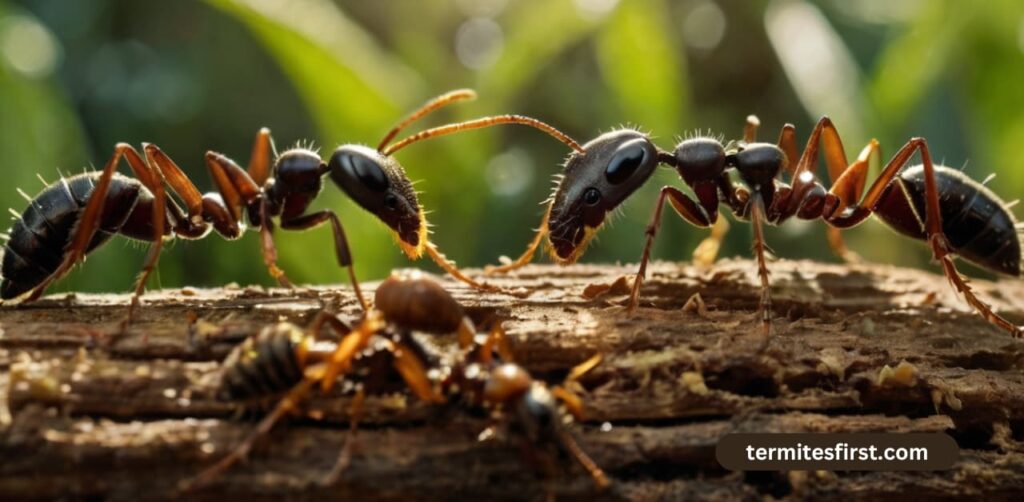
This is in contrast to termites, which have a square shaped body with no clear waist making them appear more uniform. Carpenter ants typically range from ½ inch to 1 inch in length. On the other hand, termites are much smaller and usually don’t get longer than a half-inch. These special features make it easier to spot each pest at a glance.
- Carpenter Ants: Pinched waist, three body segments, cleaner tunnels
- Termites: Rectangular body, two body segments, smaller size
Antennae Variations
The antennae of these insects provide yet another level of distinction. Carpenter ants are distinguishable by their unique elbow-shaped antennae that bend at a sharp 45-degree angle. Their segmented design only adds to their unique look.
In comparison, termites possess very straight, beaded antennae. The antennae’s floral shape is more than an attention-grabbing aesthetic. It is a key player in the insects’ behavioral ecology, helping them navigate and communicate in their complex environments.
| Feature | Carpenter Ants | Termites |
| Antennae Shape | Elbowed | Straight |
| Number of Segments | Segmented | Beaded |
Wing Structure Differences
By studying these structures, we are learning much more about these fascinating insects. Carpenter ants have two pairs of wings, known as dimorphic, with the forewings longer than the hind pair.
Termites have wings of the same length, which are extremely delicate and often shed. This fragility may be a sign of termite infestation since shed wings commonly pile up near infested structures. Wing morphology indicates reproductive stage since in both species wings are acquired during the swarm phase.
- Carpenter Ants: Larger forewings, smaller hind wings, robust structure
- Termites: Equal-length wings, fragile, indicative of swarmers
Color Distinctions
Color differences offer an additional visual hint when identifying these two pests. Carpenter ants are generally dark brown to black, with some showing reddish coloration, particularly the swarmers.
In contrast, worker termites tend to be more creamy white or even transparent. These various color differences are not merely ornamental but useful for pest control efforts, acting as distinguishing identifiers.
| Insect | Common Colors |
| Carpenter Ants | Dark brown, black, reddish |
| Termites | Creamy white, transparent |
Life Cycle Variations
Their life cycles serve to make their respective differences even more clear. Carpenter ants go through egg, larval, pupal and adult stages, emphasizing reproduction to grow their colony.
Termites take this social structure a step further with a caste system that includes workers, soldiers, and reproductives, each performing separate, specialized functions. The length of their life cycles is different too, with termites typically maturing faster.
- Carpenter Ants: Egg, larva, pupa, adult
- Termites: Egg, nymph, worker/soldier/reproductive phases
Behavioral Differences
Habitat Preferences
Carpenter ants and termites have very different habitat preferences that dramatically shape their behaviors. Carpenter ants love moist environments, so they can sometimes be found near sinks, leaky pipes and other humid places. They are fond of using soft, water-damaged wood for their nests. This enables them to capitalize on the weakened structure and easily dig out cavernous tunnels.
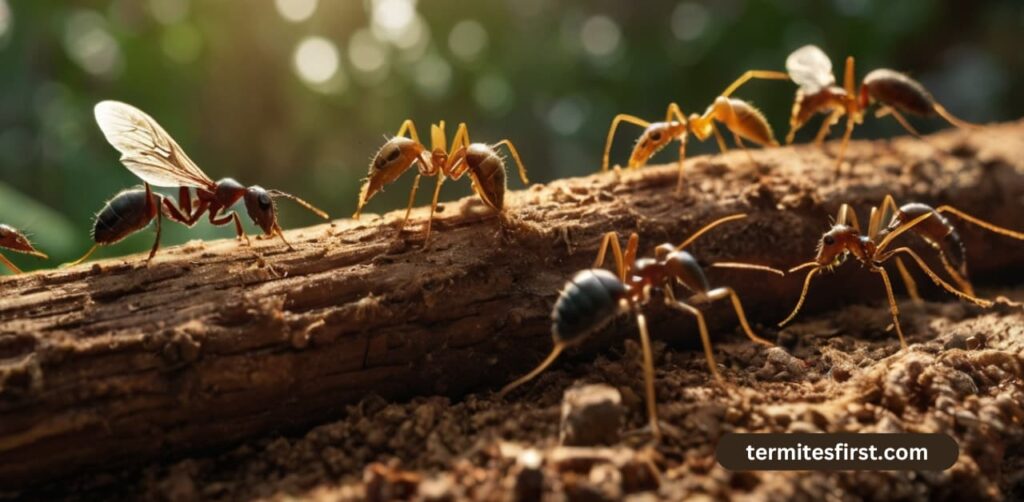
Termites—like many insects—prefer damp or decaying wood. Further, each species makes highly specific habitat selections. Subterranean termites are greatly adapted to living in soil and require some sort of bridge to moisture sources. Conversely, drywood termites can reside entirely within intact wood, with no soil connection.
Knowing what these habitat preferences are is key to maintaining effective pest control. Through integrated pest management, homeowners can learn more about environmental factors that invite pests. This way, they can implement proactive steps to minimize the chances of a home becoming infested.
Repairing leaks and making sure you have proper ventilation will help keep carpenter ants away. Plus, minimizing wood-to-soil contact prevents termite damage.
- Leaky wood near basins or sinks
- Leaky plumbing and moldy environments
- Decaying tree bark can serve the same purpose.
- Soil (for belowground species)
- Vacant building deterioration or moldy lumber
- _Behavioral Difference_Structural wood in homes
Dietary Habits
The feeding behavior of carpenter ants and termites shows striking behavioral differences. Carpenter ants are omnivorous scavengers that eat a wide range of food items including other insects, plant material, and sugars. Contrary to their names, they do not eat wood – rather, they tunnel through it to build their nests.
This behavior is the cause of structural damage as they can hollow out wood, but unlike termites, they do not get nutrition from doing so. In contrast, termites are bona fide wood-eating insects. As a group, they are known as xylophagous, wood-eating organisms which digest cellulose with the assistance of symbiotic microorganisms, such as protozoans and bacteria, in their digestive tract.
The toll of such dietary practices is most poignantly seen in the nature of injury they produce. Additionally, carpenter ants cut smooth, clean tunnels in the wood. Termites leave behind jagged, damaging galleries as they eat through the wood. The food sources are one of the main reasons carpenter ants invade homes.
These aggravating pests are attracted by food sources that are readily available.
| Trait | Carpenter Ants | Termites |
| Dietary Preferences | Omnivorous scavengers | Wood-eating insects |
| Damage Type | Structural (smooth tunnels) | Destructive (rough tunnels) |
Tunneling Patterns
Tunneling patterns offer important information when it comes to detecting infestations. Carpenter ants chew smooth, polished tunnels through the wood. They don’t even consume the wood, merely hollowing out passageways for their nests.
These tunnels are a characteristic sign of carpenter ant activity and are usually found near piles of sawdust-like debris. Termites with their bumpy meandering tunnels do quite a bit of damage. Their chewing creates a honeycomb-like pattern as they eat their way through the wood. This can greatly compromise the structural integrity of the material.
By understanding the differences in these tunneling patterns, homeowners and pest control specialists alike can identify which type of infestation they are dealing with. Carpenter ants leave smooth tunnels behind and they don’t eat the wood. Termites consume the wood, thereby killing it.
- Signs of Carpenter Ant Tunneling:
- Shiny, pristine tube-shaped tunnels
- Tons of annoying sawdust-like junk
- Occurrence of stinging ants (ant of ½ to 1 inch long)
- Signs of Termite Tunneling:
- Snagged or jagged underpasses
- Honeycomb destruction
- Mud tubes (subterranean termites)
Damage Caused by Carpenter Ants and Termites
The damage done by carpenter ants is alarming, but less overall destructive than termites. Carpenter ants chew through wood to create their nesting sites. Unlike termites, carpenter ants don’t consume wood, which creates a fine, sawdust-like debris.
This behavior typically does damage to structures such as wooden beams and furniture. It increases the threat to any wooden structures in moist environments, including bathrooms and basements. If you ignore a carpenter ant or termite infestation, their tunneling can extend for feet over time.
This willful oversight can result in repair bills of $250 to $500, even thousands if the issue goes unaddressed for years. The best way to tell if they’re invading your home is to look for frass. This material is a mixture of wood fibers and insect exoskeletons.
These ants typically range from ½ inch to 1 inch in length. They are attracted to areas with moisture, so you’ll often find them under kitchen sinks and in basements.
Carpenter Ant Damage Overview
Carpenter ants usually infest wooden structures, particularly those in wet, humid conditions. Wooden beams, furniture and structures like cabinets and moldings in bathrooms, basements and kitchens are especially at risk.
Unlike termites, carpenter ants don’t consume wood. Rather, they tunnel through it to form their homes, producing the telltale dust of fine sawdust in the process. This sawdust, or frass, usually has wood shavings and dead insect parts mixed in.
Although the damage may seem minimal at first, it can worsen if left untreated, leading to expensive repairs in the long run. Here’s a bullet list of signs indicating carpenter ant damage in homes:
- Presence of fine, sawdust-like material near wooden structures
- Hollow-sounding wood when tapped
- Visible tunnels or galleries within wooden elements
- Increased ant activity, particularly around moist areas
Termite Damage Overview
Termite destruction is much more severe because termites eat wood constantly. They can totally destroy wooden buildings, such as walls and even foundations, usually leading to repair bills of more than $3,000.
Termites are responsible each year for more than $5 billion in property damages. Signs of termite invasion, such as mud tubes and frass, are warnings of a coming threat. Untreated infestations can be long-term threats, often leaving buildings at risk of extensive structural damage.
To give a clearer understanding, I put together a visual comparison chart that captures the damage descriptions of carpenter ants vs. Termites. Further, I added a table of damage caused by different termite species.
| Damage Characteristics | Carpenter Ants | Termites |
| Wood Consumption | No | Yes |
| Frass Appearance | Sawdust, insect parts | Mud tubes, wood pellets |
| Repair Cost Range | $250 – $500+ | $3,000+ |
| Structural Impact | Moderate | Severe |
Identifying Infestations and Signs
Being able to recognize the early signs of a carpenter ant problem or a termite infestation can help homeowners avoid severe damage and expensive repairs. Both carpenter ants and destructive pests like termites can cause extensive wood damage, making it crucial to understand what signs to look for to stop this devastation.
1. Recognize Carpenter Ant Signs
Carpenter ants are typically between ½ and 1” long and are best known for their elaborate rituals involving round wooden poles. The most noticeable sign of their presence is their frass, which consists of sawdust-like material left behind as they tunnel through wood to create their nests. Understanding the key differences between carpenter ants and termites is crucial for effective pest management.
Unlike destructive pests like termites, which eat away at wood, carpenter ants chew through it, boring smooth, shiny tunnels with exit holes for pushing out frass. Discovering piles of frass around wooden features, such as door frames or support beams, is a sure sign of a carpenter ant problem.
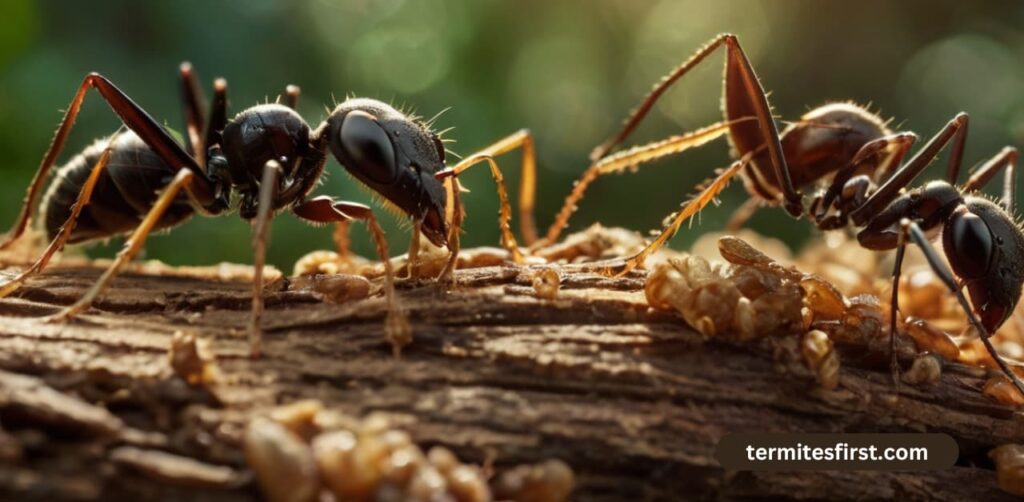
Besides frass, seeing worker ants march in a line across the ground or other surfaces can indicate an ant infestation. These ants thrive in warm, moist conditions, which can often lead basements and attics to be hotbeds of activity.
Identifying carpenter ant infestations versus other pest signs requires a keen eye. For instance, while carpenter ant swarmers create a neater appearance in wood, termites cause significant damage, leading to a more chaotic look. Recognizing these subtle differences is vital in determining the exact pest behind the issue.
Taking actionable steps to recognize carpenter ant signs can prevent further infestations and wood damage. Consulting pest control professionals can provide valuable insights into effective management strategies for these common pests.
- Check for piles of sawdust, called frass, near any wooden structures.
- Observe any ant trails, especially near moisture-prone areas.
- Look for smooth tunnels inside wood, a sign of a carpenter ant infestation.
- Inspect door frames, beams, and attic spaces regularly.
2. Detect Termite Indicators
While carpenter ants chew their way through wood, termites eat it from the inside out, showcasing a key difference between these two destructive pests. They shed a thin outer sheath that, when tapped, sounds hollow. This hollow-sounding wood is one of the biggest warning signs of termite activity.
One of the first signs of termite infestation, termites create mud tubes as protective tunnels, often located along foundation walls or wood structures. These tubes are so critical to termite survival that without them, they quickly die from dehydration.
Termite droppings, also known as frass, are another clear indicator of a pest problem. Unlike the orderly mounds of carpenter ant frass, termite droppings are more granular in nature and usually found in the vicinity of infested areas.
Routine home inspections, whether DIY or conducted by pest control professionals, can help catch early signs of an issue. Early detection is often key to avoiding significant damage and costly repairs, especially when dealing with carpenter ant swarmers.
Steps to Detect Termite Indicators can include checking for mud tubes, droppings, and hollow-sounding wood, helping homeowners spot termites before they cause extensive damage.
- Tap on wooden structures and listen for hollow sounds.
- Search for mud tubes along walls and foundations.
- Spot granular termite droppings near suspected areas.
- Schedule regular inspections, particularly in basements and crawl spaces.
Control and Prevention Methods
Whether you have an existing infestation of carpenter ants or termites, professional treatment is an important part of the solution. Both pests are capable of creating major structural damage, so it is critical that they be combatted with the utmost precision and expertise.
Professional pest control services provide treatment solutions that are most appropriate, making sure that the tactics employed are specific to the type of pest. Controlling termites, for example, often calls for a whole different set of chemicals and methods than those needed to eliminate carpenter ants.
Selecting an appropriate pest control service is your first step in prevention. For example, MightyMite in California is legendary for its termite control and has a 100% industry best “no call-back rate.” As a general rule, before selecting a pest control firm, obtain three or more quotes. This will put you in the best position to receive a great service.
Control Techniques for Carpenter Ants
To effectively control carpenter ants, a multifaceted approach is necessary. Removing food sources, like rotting wood or leaks, is the first line of prevention and control.
Cutting back all vegetation, including bushes, shrubs and overhanging trees deters these ants from invading your property. Sealing all entry points around the home is another critical step.
Using baits and traps is very important for controlling an ant population. They draw in ants with irresistible baits and systematically reduce their populations. It is important to monitor for signs of reinfestation, thereby ensuring that any resurgence is quickly and effectively addressed.
Here’s a bullet list of recommended control techniques for carpenter ants:
- Remove food sources and seal entry points
- Use baits and traps effectively
- Regularly monitor for reinfestation
- Trim vegetation around the home
Control Techniques for Termites
Termite infestations require specialized treatment such as baiting systems and chemical barrier sprays. These prevention techniques and treatment options eliminate active termite colonies and stop future damage from occurring.
The hands of a professional pest control service are often the most effective at preventing and removing infestations. What’s more, they have the technical expertise to implement these methods effectively.
Strong ongoing monitoring and prevention methods, including routine inspection and maintenance, are critical after treatment to identify and control any resurgence quickly. Here’s a bullet list of control techniques specifically for termites:
- Implement bait systems and chemical treatments
- Engage professional pest control services
- Maintain ongoing monitoring and prevention
Prevention Strategies for Both Pests
Prevention is the key to controlling carpenter ants and termites. Keeping the area dry will help keep these pests away, as they prefer a moist atmosphere.
Regular inspections of wooden structures make it easier to identify infestations early on. Sealing all cracks and crevices is fundamental to preventing pest entry.
Keep wood mulch a minimum of 12 inches from the home’s foundation. This separation allows for pest management practices to foster an unwelcoming atmosphere for pests.
Here’s a bullet list of comprehensive prevention strategies:
- Ensure a dry environment
- Conduct regular inspections
- Seal cracks and crevices
- Keep mulch away from the foundation
Conclusion
Learning the fight between carpenter ants and termites is what’s important to keeping your home safe. Each insect is a different challenge, but knowing how to identify them will lead you to finding the right solution. I learned that carpenter ants travel in visible trails and enjoy damp wood. Termites quietly eat away at the home. The damage they cause is different, but understanding the signs means faster action can be taken. Control strategies include frequent monitoring, repair of moisture issues, and closure of points of entry. This preventative approach not only saves time and money today but avoids larger problems in the future. So get informed, stay alert, and keep your space protected. Take the plunge into pest-free living and experience the tranquility that comes from knowing your home is perfectly protected.
Frequently Asked Questions
Carpenter ants have segmented bodies, bent antennae, and narrow waists. Termites have straight antennae, thick waists, and a uniform body color. Carpenter ants are typically black or red and termites are likely to be white or light brown.
Carpenter ants are primarily nocturnal and are attracted to damp wood, displaying a distinct body configuration compared to destructive pests like termites. While carpenter ants tunnel through wood, termites actively feed on wood all day, posing a significant risk of structural damage.
Carpenter ants, unlike destructive pests such as termites, don’t eat wood but tunnel through it to create nests, leading to potential structural damage over time. The main difference is that termites actively consume wood, causing significant wood damage and necessitating costly repairs.
To identify carpenter ants, look for wood shavings and ant trails, while comparing carpenter ants, you should also spot termites by searching for mud tubes, discarded wings, and hollow-sounding wood. These destructive pests leave behind very specific signs that indicate their presence.
To effectively manage a carpenter ant problem, place bait traps and seal points of entry to prevent ant species from nesting. For destructive pests like termites, utilize professional treatments such as soil barriers or baits to address potential wood damage.
Termites generally cause more extensive wood damage because they actively eat through wood, while carpenter ants, despite being destructive pests, typically weaken structures less severely than their termite counterparts.
To prevent a pest problem, keep wood as dry as possible and choose treated wood whenever feasible. Regular inspections and pest control measures can help stave off infestations from destructive pests like carpenter ants and termites.
